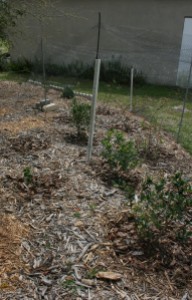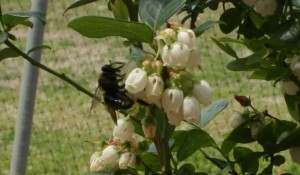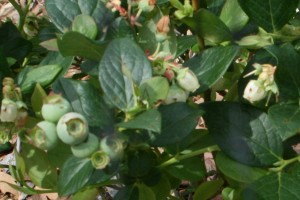We learn by doing. It’s an age-old saying for a reason. Sure, we read books, study the almanac, listen to the experts. All wonderful and recommended arenas for the novice gardener — let alone beginner — but sometimes, there’s simply no substitute for experience. The tried and true kind.
Take my blueberry patch. My pride and joy, my special morning ritual (well, once it’s established I plan to make it a morning ritual – plucking fresh blueberries for my yogurt and bran flakes…strolling amidst the chirps and peeps). Well, you understand. You work hard for these sweet, luscious, high in anti-oxidant fruits and you don’t want to lose them to the natural elements. Wind, pests, birds.
Birds are a definite problem when it comes to berries. They too enjoy a plump serving of berries with their breakfast! But they’re hungry varmints and will eat you out of house and home – house and garden – if you let them. But me, I count myself as smarter than the average bear (no pun intended to my other native blueberry fan). I figure I can outwit these flying friends with a simple bird net. Says so right on the package. Bird nest for fruit and shrubs.
Wonderful. Problem solved. All I have to do is cover my plants — all twelve of them — and I’m off and running in the blueberry race. Woohoo!
First recommendation: don’t choose a windy day to start your net project. Blueberry blossoms are extremely sensitive to the slightest tactile cling and snare easily. Translated: touch them and they pop off the vine. Bad. Very bad. No blossoms means no berries.
With a little practice, though, I became quite good at throwing and securing my net without touching my delicate blueberry blossoms and only lost a few to the endeavor. Can you really miss what you never had to start? If you’ve noticed, philosophy seems to be on overdrive in my garden.
But abstract distractions aside, I finished my task an hour later, rising with a nice long yoga stretch to the back before I secured my last stake in the ground. Second recommendation: don’t attempt this after several hours of weeding and tilling in the garden. Problem is, I’m more doer than planner. Oh look, I still have two hours before I need to pick up the kids! What else can I slip in before my time runs out?
That’s when I heard it.
Bzzzzzz. Bzzzzzzz.
I looked up and honed in on my little bee friend. Okay, it was one of my BIG bee friends, but nonetheless, a bee friend. There he was, patiently, persistently, hovering about the outside of my netting.
Realization trickled down through my tired, aching limbs. He’s outside the netting. Outside my netting!
In addition to my Rabbit Eyes, I planted High Bush blueberry varieties. They need cross pollination. By bees.
Aaaaargh! Not only had I effectively kept the birds out, I was keeping my bee friends out, too! Bad, bad, bad. If you want your blossoms to grow and provide — which I do — you need bees.
Now I was in a bind. What to do? Leave my hard work in place, or tear it down so the bees can enter safely and do their business? Since I’m no expert, this was a tough call, because I don’t know when the plants actually need pollination. Do they bloom after pollination and blossom into blueberries? Or do they need pollination between bloom and blueberry? How the heck do I know? I’m just a berry enthusiast trying my hand at a blueberry patch! I have no idea how Mother Nature runs these things.
After two minutes of hair pulling, you know I pulled the netting down. No way around it. It made more sense that when there are flowers present — and I have tons of flowers present — they need bees. Bees work the flowers!
Later that night, I shared the events with my husband who promptly replied, “The bees will get through.”
“No,” I stated, calm and matter-of-fact. I was calm by now, having had several hours to absorb the incident. “The netting holes are this big,” I made a circle with my thumb and forefinger to simulate the size less than a dime. “The bees are this big.” A centimeter larger, and granted, undetectable with my fingers, but my point was clear. Too close to call. A bee may try it, but he would most likely be snagged. Wings. They’d throw him over the threshold of size “allowability.”
Determined as any man would be, my husband remained convinced there was a way to beat the problem. Sure enough, next day, the birds were swooping on my plants, sending my heart racing. Eyeing my poles already in place, I was determined to win this one. No wind, it was much easier to assemble my netting “cage” and took ten minutes. Satisfied it would work, I went to the garden.
Tormented by thoughts of harming the bees, I thought maybe the answer was mobile netting. I could put up and take down the netting on a daily basis, according to the bird’s feeding schedule. “Do they have a feeding schedule?” Mine seem to eat all day long!
Trekking back to the house from the garden, collecting my kitchen compost bin along the way, I heard it.
Yep, you guessed it. My bee friend was back! I swung my head around hoping to catch sight of him and sure enough, there he was, hovering about a blueberry plant.
Inside the netting. I rushed over for a closer look, wondering how exactly he managed entry. Pleasure poured through me. There, where my two nets overlap, was at least a foot of space. Perfect. Bees could easily maneuver this section while birds could not. They wouldn’t even attempt to sail through for fear they would be unable to escape, and thus be trapped. (Birds don’t hover as well as bees. They need some distance for landing and take-off.)
Heaving a sigh of relief, I headed into the house. Problem solved.
And not a moment too soon. My blueberries are nearing maturity!
Look at these beauties. They’re still green, but big and round and about to turn blue.









Hi….I’m in need of help!!….well hopefully I will be if my conch peas do well…they have just poked thru the soil (very cute!)..Anyways..how do you freeze conch peas? Thanks so much for any info 🙂
Patti – Your peas will do fine, don’t worry! As to freezing them, it’s easy. Simply remove the peas from their pods and blanch — boil briefly — for about 90 seconds, then immediately put them in a bowl of ice water to prevent further cooking. After about a minute or so, you can remove them from the water, pat dry, and place them in a freezer proof air-tight plastic bag – or similar container – and freeze. Easy!
I use this same process for my Lima beans. Dry beans such as my black turtle and red kidney store dry — once you let them “air out” for a day or so after picking. If you don’t, they’ll turn “moldy” in your airtight container. Hard lesson to learn when you’re excited to eat your first batch.
And remember: dry beans must be soaked well and rinsed before eating as they can be dangerous to the digestive system if eaten raw. Check my earlier post on Black Beans.
Thanks for stopping by and good luck!